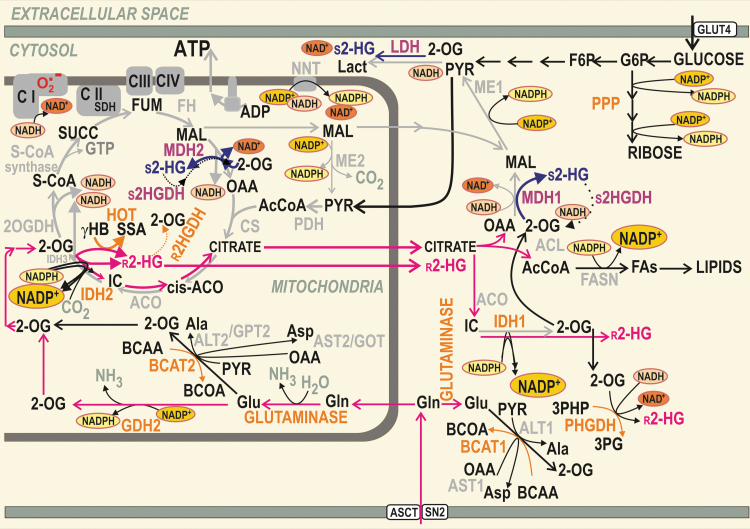FIG. 1.
Typical cancer metabolism related to the formation of r-2HG and s-2HG. Examples of reactions (not necessary occurring within a single cancer cell type) are depicted within the context of reductive carboxylation reactions of cytosolic IDH1 and mitochondrial IDH2 accompanying glutaminolysis (neon red arrows). The concomitant NADPH/NADP+ and NADH/NAD+ equilibria are emphasized (larger symbols point to accumulation of the nicotine amide nucleotide). Complete NADPH-dependent reductive carboxylation by IDH2 leads to IC formation followed by the citrate's export from the mitochondrial matrix. The minor alternative reductive reaction of IDH2 forms r-2HG at the expense of NADPH. HOT/ADHFE1 competes with IDH2 for 2OG, but upon the conversion of γ-hydroxybutyrate (γHB) to SSA also synthesizes r-2HG. Its specific matrix dehydrogenase (r2HGDH) slowly degrades r-2HG, which may be also exported from mitochondria by an as yet unknown mechanism. The minor NADH-dependent side reaction of the matrix malate dehydrogenase MDH2 may also convert 2OG to s-2HG under specific conditions. The resulting s-2HG can be slowly degraded by the s2HGDH. The export of s-2HG is omitted for simplicity. Mitochondrial glutaminase and cancer-specific glutamate dehydrogenase GDH2 (insensitive to GTP inhibition) supply 2OG for IDH2 and HOT reactions and the forward Krebs cycle. 2OG is rather consumed by the branched chain aminotransferase BCAT2 when β-like oxidation of the produced branched-chain oxoacids proceeds. Similar BCAT1-mediated reaction can occur in the cytosol. In contrast, during typical glutaminolysis, 2OG is supplied to the Krebs cycle owing to reactions of alanine aminotransferases ALT2 (also termed glutamate pyruvate transaminase GPT2) or aspartate aminotransferase AST2/GOT2 (glutamate oxaloacetate transaminase 2). In the cytosol, 2OG can be alternatively split into s-2HG by an NADH-dependent side reaction of LDH. 2OG can be similarly converted to s-2HG by the cytosolic MDH1. Also, cytosolic s2HGDH has been described to degrade cytosolic s-2HG. In turn, major cytosolic reactions producing r-2HG are those of IDH1 (NADPH-dependent) and PHGDH (NADH-dependent). γHB, γ-hydroxybutyrate; 2HG, 2-hydroxyglutarate; 2OG, 2-oxoglutarate; ACL, ATP citrate lyase; ACO, aconitase; ASCT, SN2, glutamine carriers; AST2/GOT2, glutamate oxaloacetate transaminase 2; BCAT, BCAA aminotransferases; CS, citrate synthase; FASN, fatty acid synthase; FH, fumarate hydratase; FUM, fumarate; GDH, glutamate dehydrogenase; GLUT, glucose transporter; HOT/ADHFE1, hydroxyacid-oxoacid transhydrogenase/alcohol dehydrogenase iron-dependent isoform 1; IC, isocitrate; IDH1, isocitrate dehydrogenase isoform 1; IDH2, isocitrate dehydrogenase isoform 2; Lact, lactate; LDH, lactate dehydrogenase; MAL, malate; MDH, malate dehydrogenase; OAA, oxaloacetate; PHGDH, phosphoglycerate dehydrogenase; PYR, pyruvate; r-2HG, r-2-hydroxyglutarate; s-2HG, s-2-hydroxyglutarate; S-CoA, succinyl coenzyme A; SDH, succinate dehydrogenase; SSA, succinic semialdehyde; SUCC, succinate.

